10 of History's Most Torturous Methods of Execution
Matt Arone
Published
04/06/2015
in
creepy
A collection of torturous methods of execution that you would not want to be apart of, ever.
- List View
- Player View
- Grid View
Advertisement
-
1.
 Scaphism: The naked person was firmly fastened within a back-to-back pair of narrow rowing boats, with the head, hands, and feet protruding. The condemned was forced to ingest milk and honey to the point of developing severe diarrhea, and more honey would be rubbed on his body in order to attract insects to the exposed appendages. The feeding would be repeated each day in some cases to prolong the torture, so that dehydration or starvation did not provide him or her with the release of death.
Scaphism: The naked person was firmly fastened within a back-to-back pair of narrow rowing boats, with the head, hands, and feet protruding. The condemned was forced to ingest milk and honey to the point of developing severe diarrhea, and more honey would be rubbed on his body in order to attract insects to the exposed appendages. The feeding would be repeated each day in some cases to prolong the torture, so that dehydration or starvation did not provide him or her with the release of death. -
2.
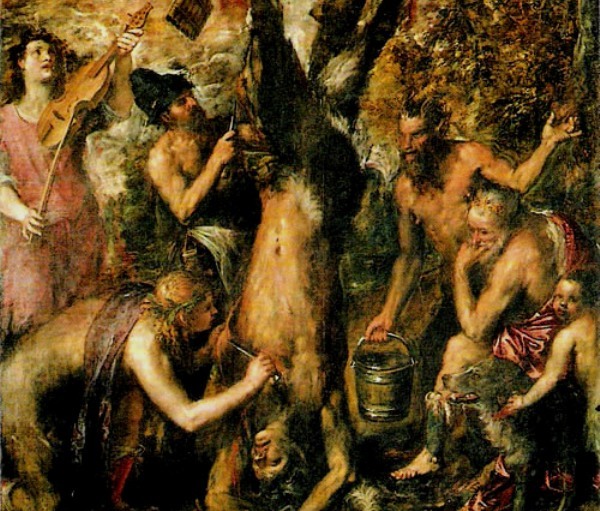 Flaying: Flaying is the removal of skin from the body. Flaying of humans was used as both a method of torture and execution, depending on how much of the skin is removed.
Flaying: Flaying is the removal of skin from the body. Flaying of humans was used as both a method of torture and execution, depending on how much of the skin is removed. -
3.
 Lingchi: Also known as slow slicing, Lingchi was reserved for crimes viewed as especially severe, such as treason and killing one’s parents. The process involved tying the condemned to a wooden frame, usually in a public place. The flesh was then cut from the body in multiple slices in a process that was not specified in detail in Chinese law and therefore most likely improvised.
Lingchi: Also known as slow slicing, Lingchi was reserved for crimes viewed as especially severe, such as treason and killing one’s parents. The process involved tying the condemned to a wooden frame, usually in a public place. The flesh was then cut from the body in multiple slices in a process that was not specified in detail in Chinese law and therefore most likely improvised. -
4.
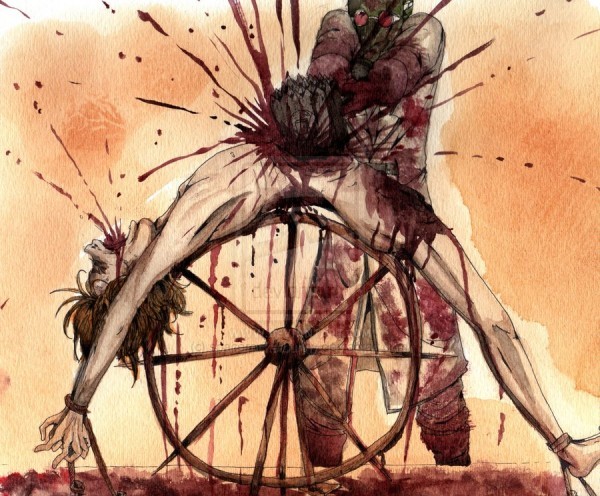 Breaking Wheel: The wheel was typically a large wooden wagon wheel with many radial spokes, but a wheel was not always used. In some cases the condemned were lashed to the wheel and beaten with a club or iron cudgel, with the gaps in the wheel allowing the cudgel to break through. It was used during the Middle Ages and was still in use into the 19th century.
Breaking Wheel: The wheel was typically a large wooden wagon wheel with many radial spokes, but a wheel was not always used. In some cases the condemned were lashed to the wheel and beaten with a club or iron cudgel, with the gaps in the wheel allowing the cudgel to break through. It was used during the Middle Ages and was still in use into the 19th century. -
5.
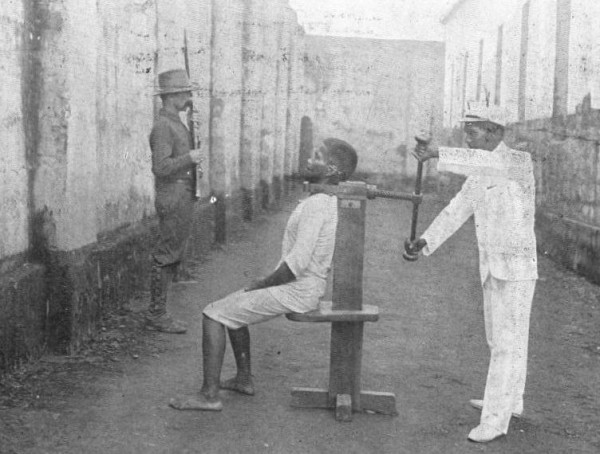 Garrote: The garrote is a device that strangles a person to death. It can also be used to break a person’s neck. Some versions of the garrote incorporated a metal bolt which pressed in to the spinal chord, breaking the neck. The victim may pass into a state of severe and painful convulsions and then pass into death.
Garrote: The garrote is a device that strangles a person to death. It can also be used to break a person’s neck. Some versions of the garrote incorporated a metal bolt which pressed in to the spinal chord, breaking the neck. The victim may pass into a state of severe and painful convulsions and then pass into death. -
6.
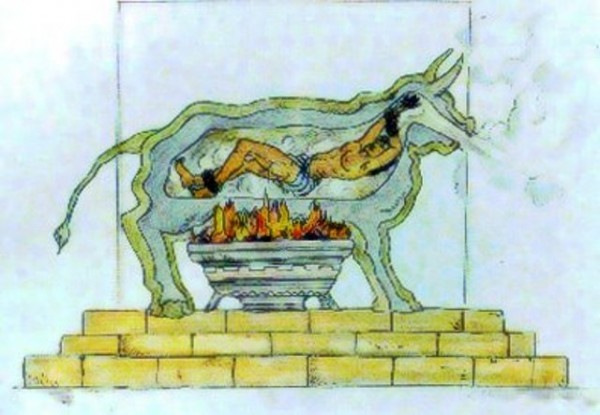 Brazen Bull or the Sicilian Bull: An execution device designed in ancient Greece.The condemned were shut in the bull and a fire was set under it, heating the metal until it became yellow hot and causing the person inside to roast to death. The bull was designed in such a way that its smoke rose in spicy clouds of incense. The head of the ox was designed with a complex system of tubes and stops so that the prisoner’s screams were converted into sounds like the bellowing of an infuriated bull. It is also said that when the bull was reopened, the scorched bones of the remains shone like jewels and were made into bracelets.
Brazen Bull or the Sicilian Bull: An execution device designed in ancient Greece.The condemned were shut in the bull and a fire was set under it, heating the metal until it became yellow hot and causing the person inside to roast to death. The bull was designed in such a way that its smoke rose in spicy clouds of incense. The head of the ox was designed with a complex system of tubes and stops so that the prisoner’s screams were converted into sounds like the bellowing of an infuriated bull. It is also said that when the bull was reopened, the scorched bones of the remains shone like jewels and were made into bracelets. -
7.
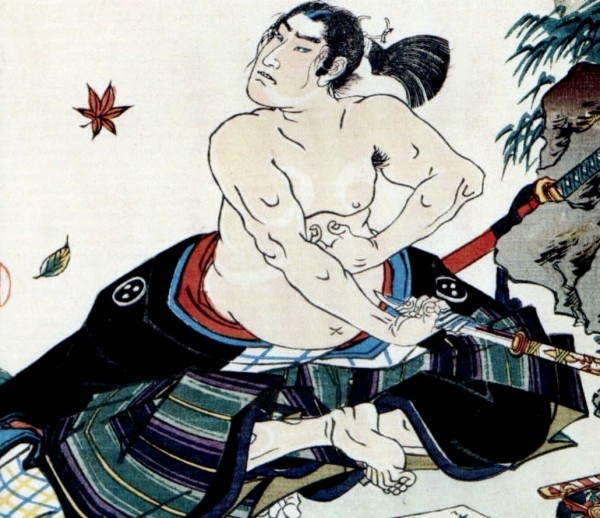 Disembowelment: The removing of some or all of the vital organs, usually from the abdomen. The last organs to be removed were invariably the heart and lungs so as to keep the condemned alive (and in pain) as long as possible. Disembowelment played a part as a method of execution and ritual suicides once in Japan.
Disembowelment: The removing of some or all of the vital organs, usually from the abdomen. The last organs to be removed were invariably the heart and lungs so as to keep the condemned alive (and in pain) as long as possible. Disembowelment played a part as a method of execution and ritual suicides once in Japan. -
8.
 Boiling: This method was used in Russia and Europe 3000 years ago and they used oil, acid or water. This type is considered slow and extremely painful. This penalty was carried out using a large cauldron filled with water, oil, tar, tallow or even molten lead. Sometimes the victim was immersed, the liquid then being heated, or he was plunged into the already boiling contents, usually head first.
Boiling: This method was used in Russia and Europe 3000 years ago and they used oil, acid or water. This type is considered slow and extremely painful. This penalty was carried out using a large cauldron filled with water, oil, tar, tallow or even molten lead. Sometimes the victim was immersed, the liquid then being heated, or he was plunged into the already boiling contents, usually head first. -
9.
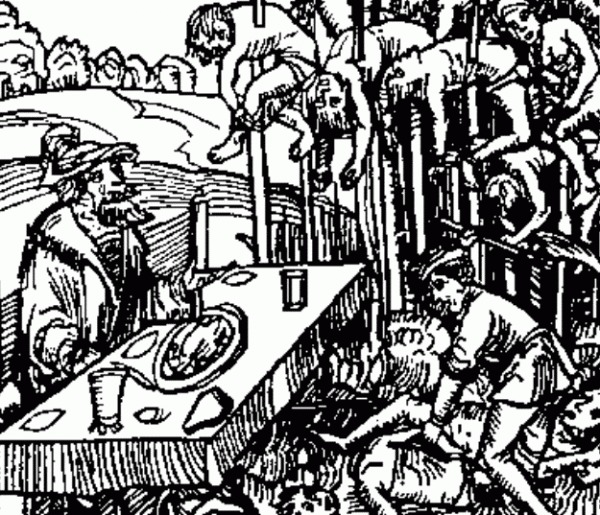 Impalement: Impalement as a method of execution involves a person being pierced with a long stake. The penetration could be through the sides, through the rectum, through the vagina, or through the mouth. This method leads to a painful death, sometimes taking days.
Impalement: Impalement as a method of execution involves a person being pierced with a long stake. The penetration could be through the sides, through the rectum, through the vagina, or through the mouth. This method leads to a painful death, sometimes taking days. -
10.
 Drawing and Quartering: First the convict is dragged on a hurdle (a wooden frame) to the place of execution. This is one possible meaning of drawn, then he is hanged by the neck for a short time or until almost dead. After that he is disemboweled and castrated, and the genitalia and entrails are burned before the condemned’s eyes. Finally the body is beheaded and divided into four parts.
Drawing and Quartering: First the convict is dragged on a hurdle (a wooden frame) to the place of execution. This is one possible meaning of drawn, then he is hanged by the neck for a short time or until almost dead. After that he is disemboweled and castrated, and the genitalia and entrails are burned before the condemned’s eyes. Finally the body is beheaded and divided into four parts.
Scaphism: The naked person was firmly fastened within a back-to-back pair of narrow rowing boats, with the head, hands, and feet protruding. The condemned was forced to ingest milk and honey to the point of developing severe diarrhea, and more honey would be rubbed on his body in order to attract insects to the exposed appendages. The feeding would be repeated each day in some cases to prolong the torture, so that dehydration or starvation did not provide him or her with the release of death.
10/10
1/10
Categories:
Creepy



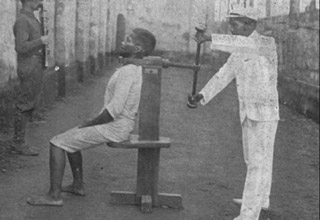





50 Comments